
The Bottom Line
Introduction + XFX OVERSPECED Design
XFX had my attention with this review when they named the card the "Radeon RX 6800 XT Speedster MERC 319" alone, but once I played around with the card and put it through its paces, it has earned my heart.
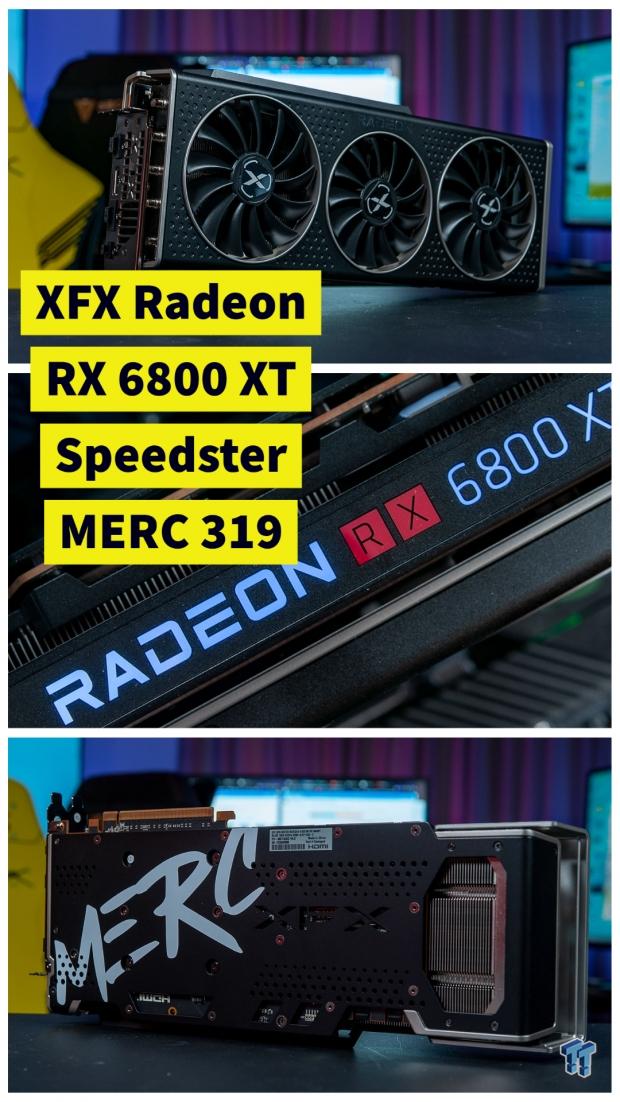
The new XFX Radeon RX 6800 XT Speedster 319 is a great graphics card that its unique name aside, has some killer performance. It's everything AMD's own Radeon RX 6800 XT reference graphics card, and more -- it's bigger, it's much cooler, much quieter, and packs a very nice additional punch -- and as a bonus, some great OC abilities, too.
XFX is using a custom PCB here, with a huge 2.7-slot card that rocks a triple-fan cooler and (surprisingly) only 2 x 8-pin PCIe power connectors. XFX is throwing on another $50 premium for the Radeon RX 6800 XT Speedster MERC 319 at $749 (versus $699 for the reference RX 6800 XT).
Everything from the retail box to the card itself is over-the-top and I love that, XFX isn't shy -- and rightfully so, it has a larger-than-life Big Navi card on its hands. Out of the box you're going enjoying higher GPU clocks -- I was seeing around 2400MHz -- while when overclocked, the XFX RX 6800 XT Speedster MERC 319 is pushing 2650MHz.
OVERSPECED Design
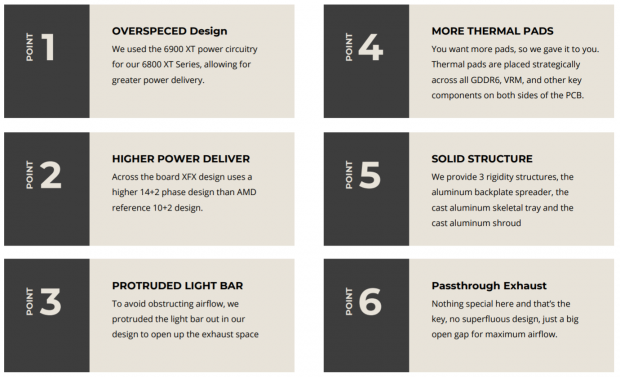
XFX has gone overboard in all the right ways with the RX 6800 XT Speedster MERC 319, with the power circuitry from the higher-end Radeon RX 6900 XT used on their RX 6800 XT series graphics cards. XFX is using many more thermal pads (you can see them easily on the card) and a PCB with a higher 14+2 phase design (up from the 10+2 on the reference card).

Everything You Need to Know About RDNA 2
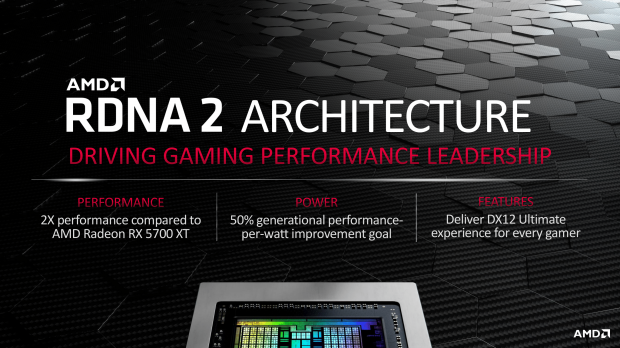
AMD's new RDNA 2 architecture has more changes than any previous-gen GPU architecture I can remember from AMD (and even ATi) in the last 10+ years.

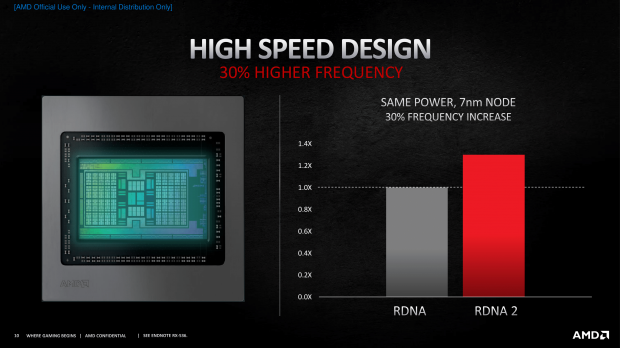
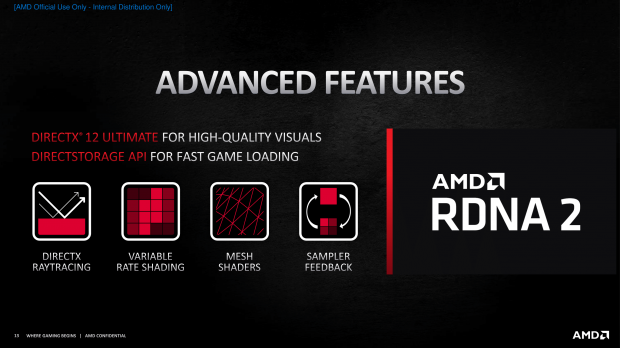
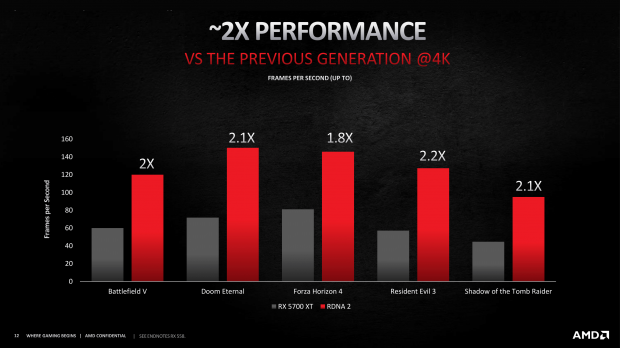
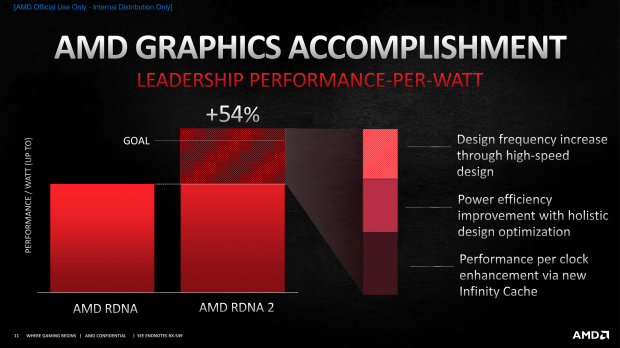
There's a lot to go over here, but we're looking at an enhanced compute unit, new visual pipeline featuring Ray Accelerators, and the all-new (and very exciting) Infinity Cache (which I'll go into on the next page. We're looking at a huge 1.54x higher performance-per-watt and 1.3x higher frequency at the same per-CU power -- impressive stuff, AMD.
Ray Accelerators
One of the largest new introductions in the new RDNA 2 architecture is the high-performance ray tracing acceleration architecture known as the Ray Accelerator. AMD doesn't have NVIDIA-beating ray tracing performance, but it's here in RDNA 2.
Each Ray Accelerator is capable of calculating up to 4 ray / box intersections, and 1 ray / triangle intersection every clock. This means the RDNA 2-based Ray Accelerators can efficiently calculate the intersections of the rays with the scene geometry as represented in a Bounding Volume Hierarchy, sorts them, and returns the information to the shaders for further scene traversal or result shading.
HDMI 2.1
This is another big deal -- HDMI 2.1 connectivity.
HDMI 2.1 ushers in the worlds of 4K 120Hz and 8K 60Hz through a single HDMI 2.1 cable to your flashy new TV or gaming monitor. Personally I own a new CX series LG OLED TV with HDMI 2.1 that drives its 4K 120Hz, so plugging my gaming PC into my TV can only be done a single way if I want 4K 120Hz -- which I kinda do.
The introduction of HDMI 2.1 on graphics cards began with NVIDIA's new GeForce RTX 30 series, and continues with AMD's new Radeon RX 6000 series graphics cards. All 3 of the new Radeon RX 6000 series cards -- the Radeon RX 6900 XT (coming soon), the Radeon RX 6800 XT (review here) and Radeon RX 6800 (this review) all have HDMI 2.1 output.
Board Design

Another great thing AMD did with the Radeon RX 6800 XT and Radeon RX 6800 graphics cards is the board design, with the company making all 3 of the cards at a standard ~10.5 inches or so. The card is also max 2.5-slot for reference boards, which means it'll slot into virtually any PC that is capable of taking a regular-sized card.
What Is Infinity Cache?
Now this is where things get really interesting -- Infinity Cache, which provides some kick ass memory bandwidth even with it smaller 256-bit memory bus and slower GDDR6 memory.

NVIDIA might have a superior 320-bit memory bus, faster GDDR6X -- but it has less VRAM (10GB versus 16GB) and the Radeon RX 6800 XT still kicks ass against the GeForce RTX 3080 in all resolutions and situations. But in the right situation -- like when paired with a Zen 3 processor, like I've done preliminary with the Ryzen 9 5900X -- you can get in excess of 10% more performance when you add SAM (Smart Access Memory) into the equation.
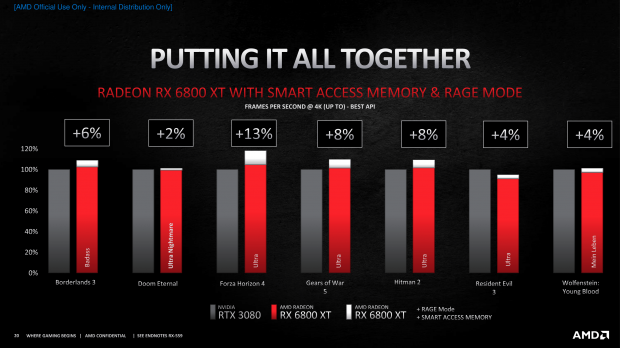
If you've got the right hardware -- a new RDNA 2-based Radeon RX 6800 XT for example, with a Zen 3-based Ryzen 5000 series -- like the Ryzen 9 5900X that I got in the days leading into the review. I will have some numbers on those tomorrow, but I needed to get these reviews out first.
The SAM results are as good as you see in these charts, and in some cases better -- it's an impressive thing to see, and I truly can't wait to see more from Smart Access Memory technology.
Detailed Look
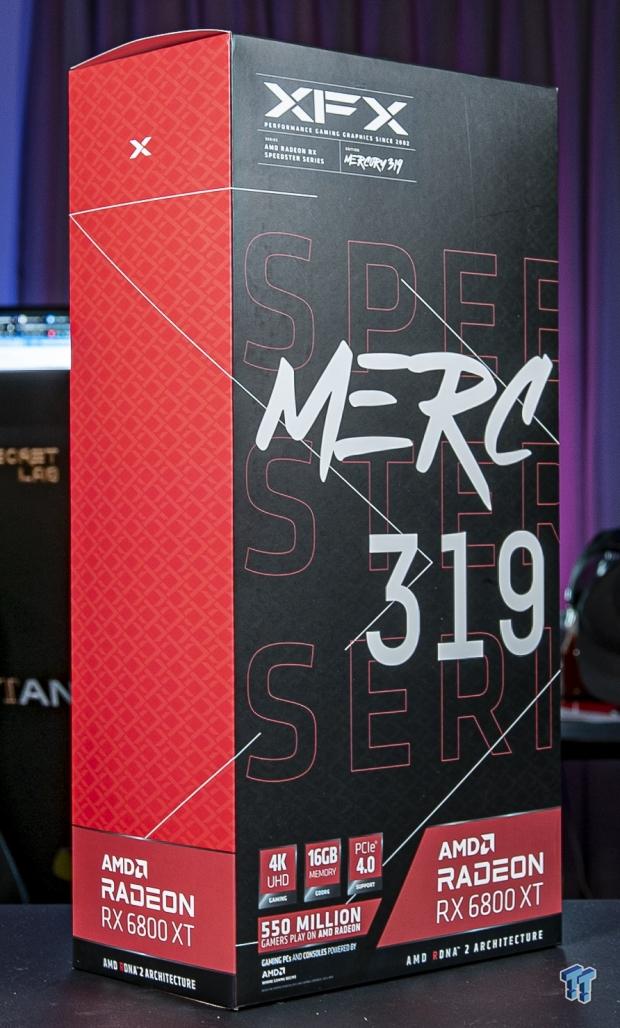
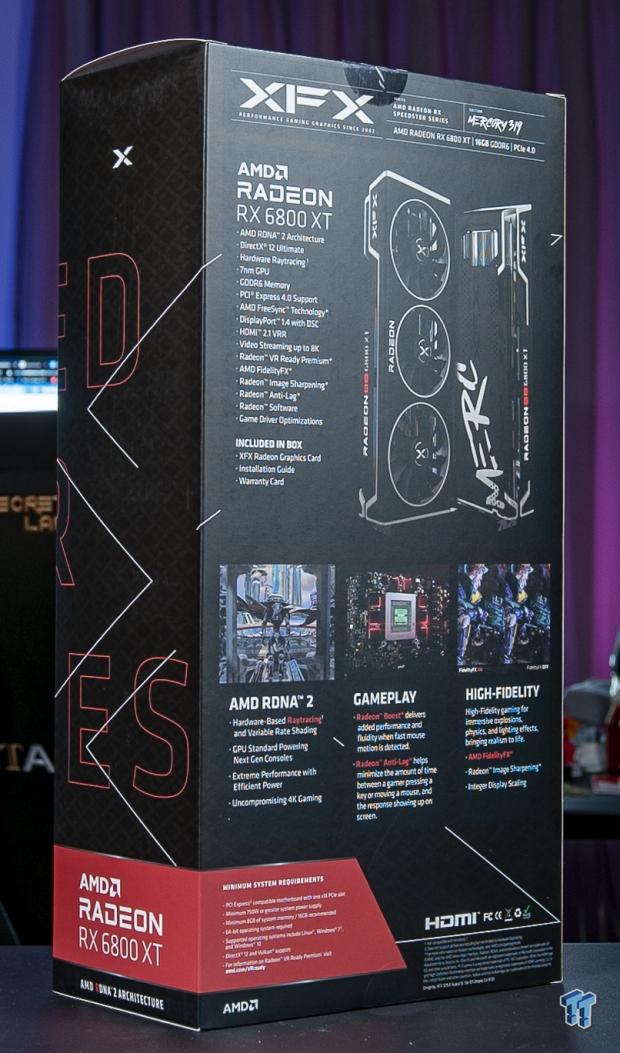
Man, the retail packaging for the XFX Radeon RX 6800 XT Speedster MERC 319 is bigger than the name! It looks great, and will look different on your shelf -- if you're a box collector, like me. I love nerding out over the different retail boxes of PC hardware.
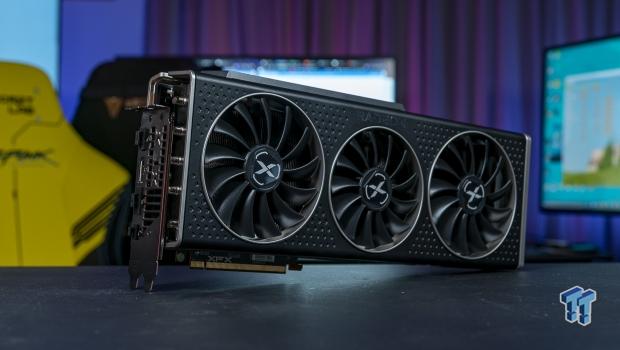
I have to admit that I wasn't a fan of the design of this card when it leaked online, but in person I actually came to admire it. From the front the RX 6800 XT Speedster MERC 13 looks great with its triple-fan cooler, that keeps the card super-cool btw.

You're either going to love or hate the back of the card with the huge 'MERC' branding.


We have a 2.5-slot card here, with dual 8-pin PCIe power connectors -- there are some custom models on the market that require 3 x 8-pin PCIe power connectors.
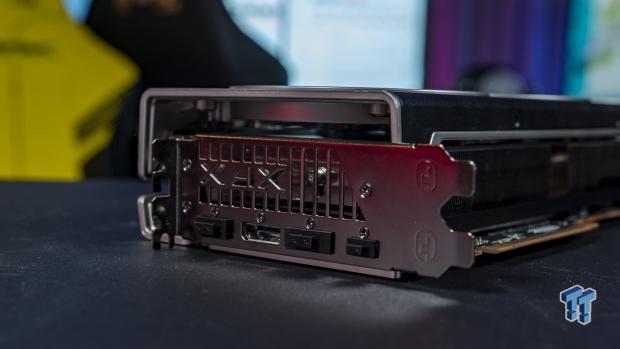

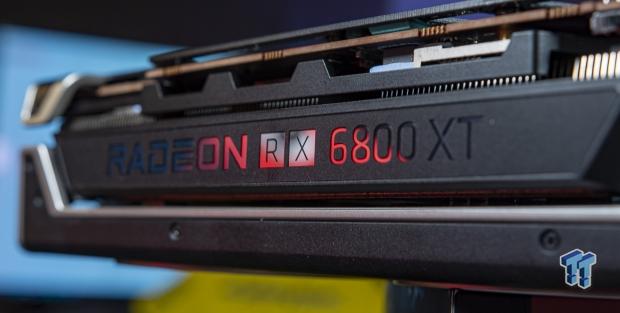
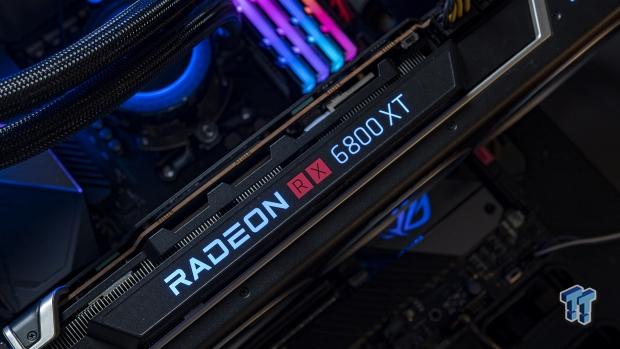
Test System Specs
Latest upgrade:
Sabrent sent over their huge Rocket Q 8TB NVMe PCIe M.2 2280 SSD, which will be my new Games install SSD inside of my main test bed.
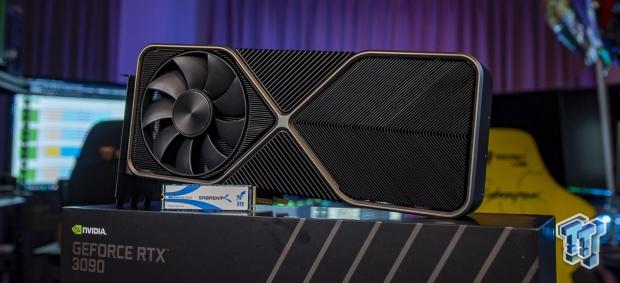
I've got a new upgrade inside of my GPU test bed before my change to a next-gen test bed, where I will be preparing for NVIDIA's next-gen Ampere graphics cards and AMD's next-gen RDNA 2 graphics cards.
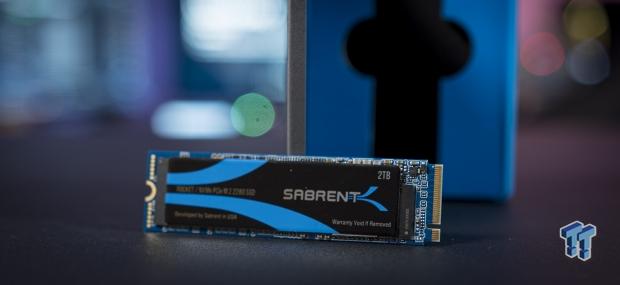
Sabrent helped out with some new storage for my GPU test beds, sending over a slew of crazy-fast Rocket NVMe PCIe M.2 2280 SSDs. I've got this installed into my GPU test bed as the new Games Storage drive, since games are so damn big now. Thanks to Sabrent, I've got 2TB of super-fast M.2 PCIe 3.0 x4 SSD storage now.

Anthony's GPU Test System Specifications
I've recently upgraded my GPU test bed -- at least for now, until AMD's new Ryzen 9 5950X processor is unleashed then the final update for 2020 will happen and we'll be all good for RDNA 2 and future Ampere GPU releases. You can read my article here: TweakTown GPU Test Bed Upgrade for 2021, But Then Zen 3 Was Announced.

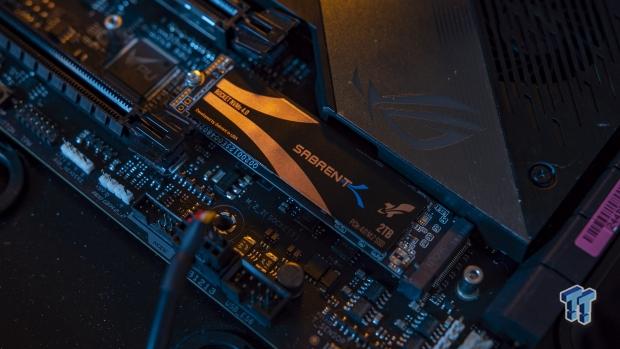
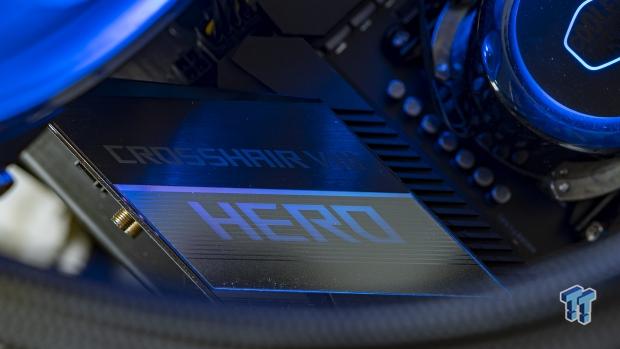
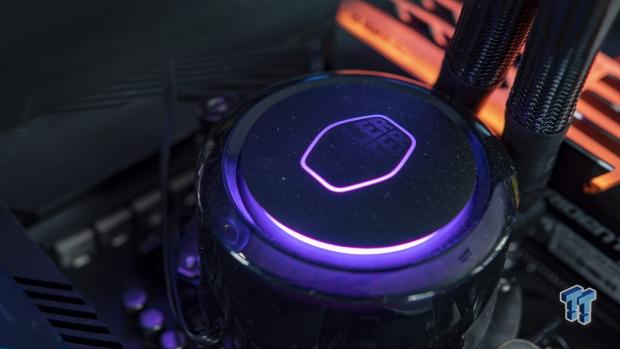
- CPU: AMD Ryzen 7 3800X (buy from Amazon)
- Motherboard: ASUS ROG X570 Crosshair VIII HERO (buy from Amazon)
- Cooler: CoolerMaster MasterLiquid ML360R RGB (buy from Amazon)
- RAM: G.SKILL Trident Z NEO RGB 32GB (4x8GB) (F4-3600C18Q-32GTZN) (buy from Amazon)
- SSD: Sabrent 2TB Rocket NVMe PCIe 4.0 M.2 2280 (buy from Amazon)
- PSU: be quiet! Dark Power Pro 11 1200W (buy from Amazon)
- Case: InWin X-Frame 2.0
- OS: Microsoft Windows 10 Professional x64 (buy from Amazon)
Benchmarks - Synthetic
3DMark Fire Strike
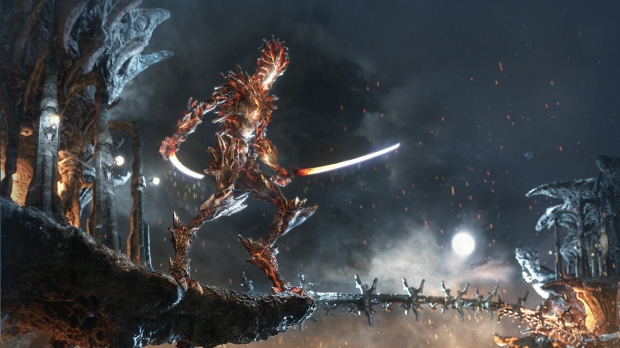
3DMark has been a staple benchmark for years now, all the way back to when The Matrix was released and Futuremark had bullet time inspired benchmarks. 3DMark is the perfect tool to see if your system - most important, your CPU and GPU - is performing as it should. You can search results for your GPU, to see if it falls in line with other systems based on similar hardware.
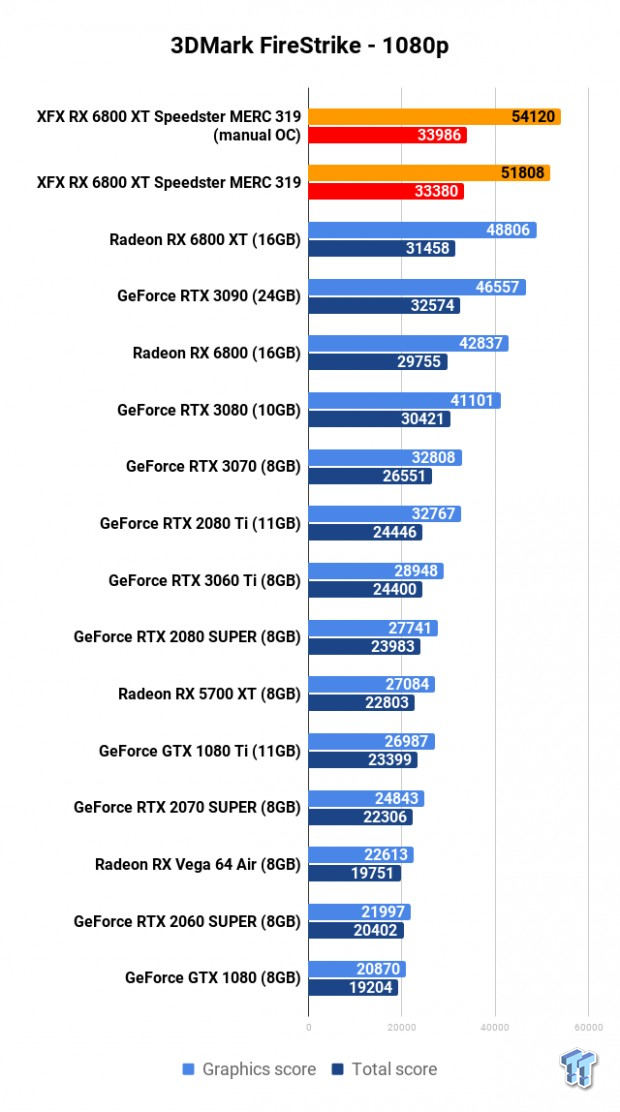
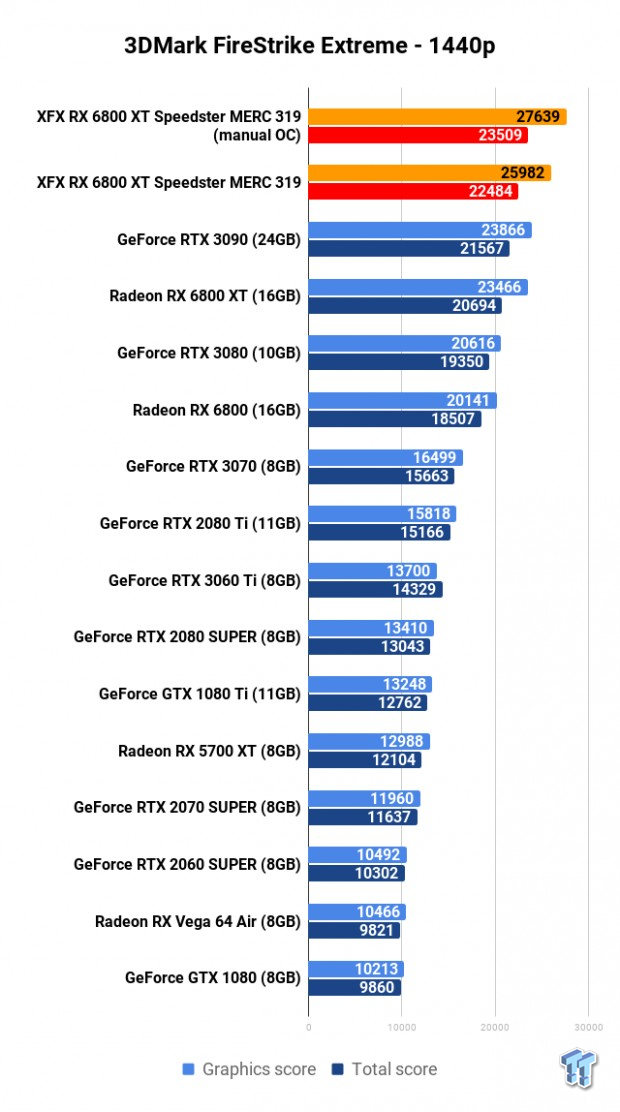
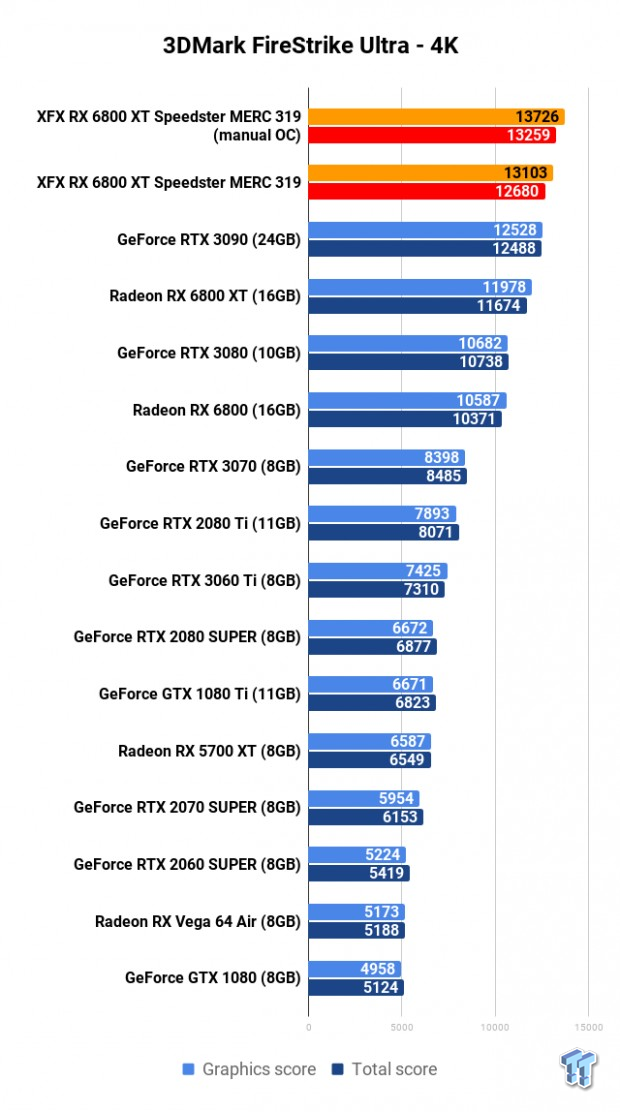
3DMark TimeSpy
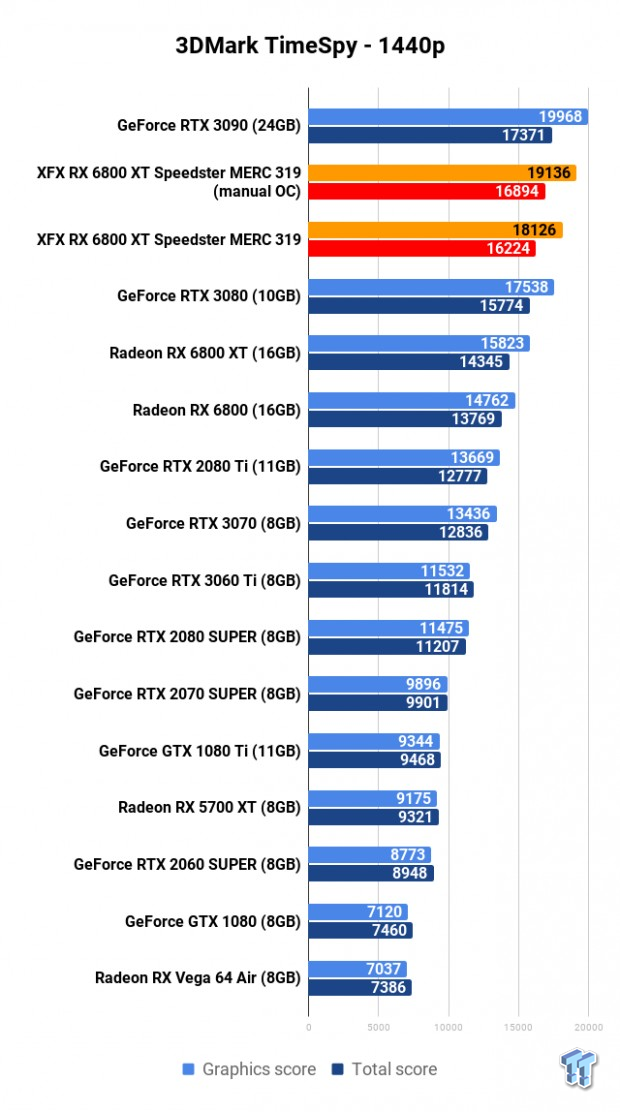
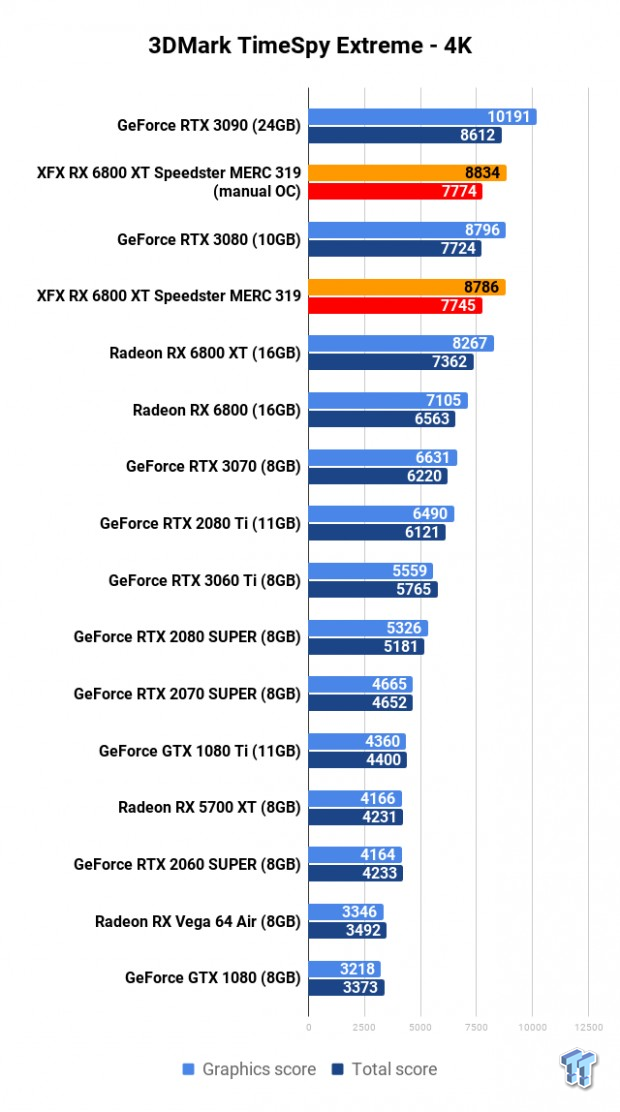
Heaven - 1080p
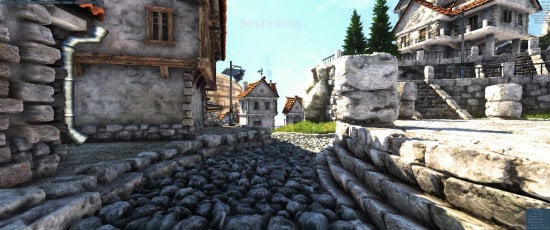
Heaven is an intensive GPU benchmark that really pushes your silicon to its limits. It's another favorite of ours as it has some great scaling for multi-GPU testing, and it's great for getting your GPU to 100% for power and noise testing.
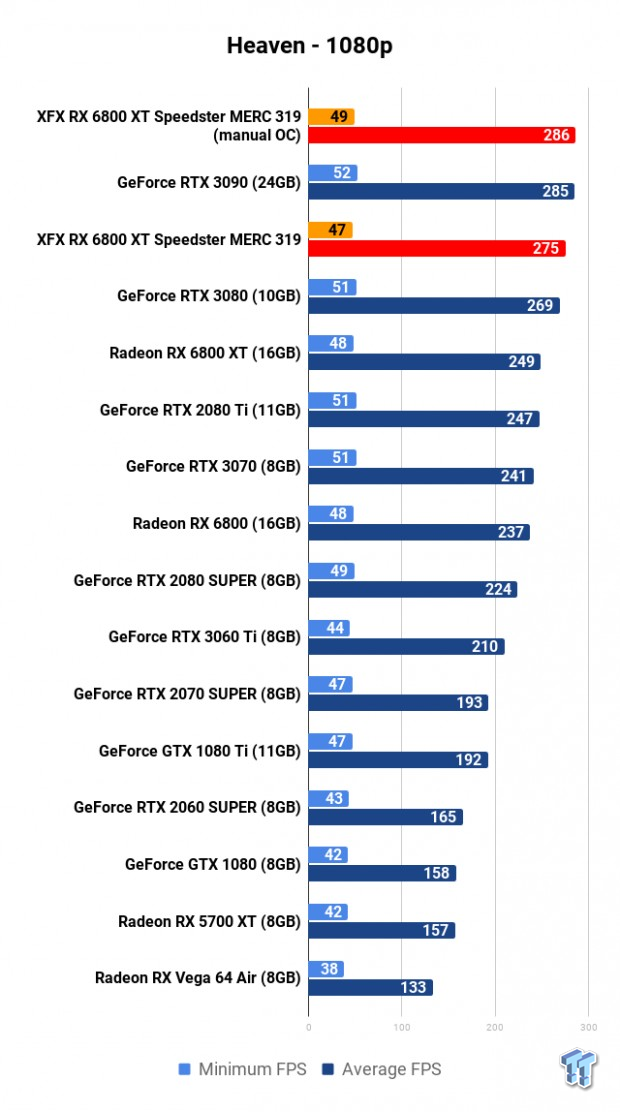
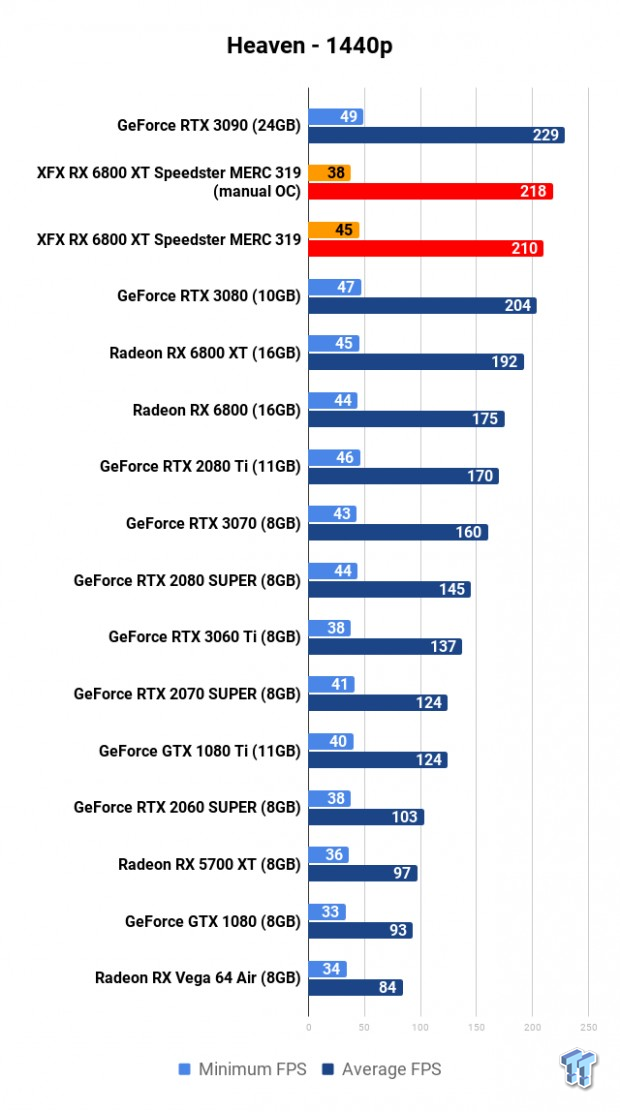
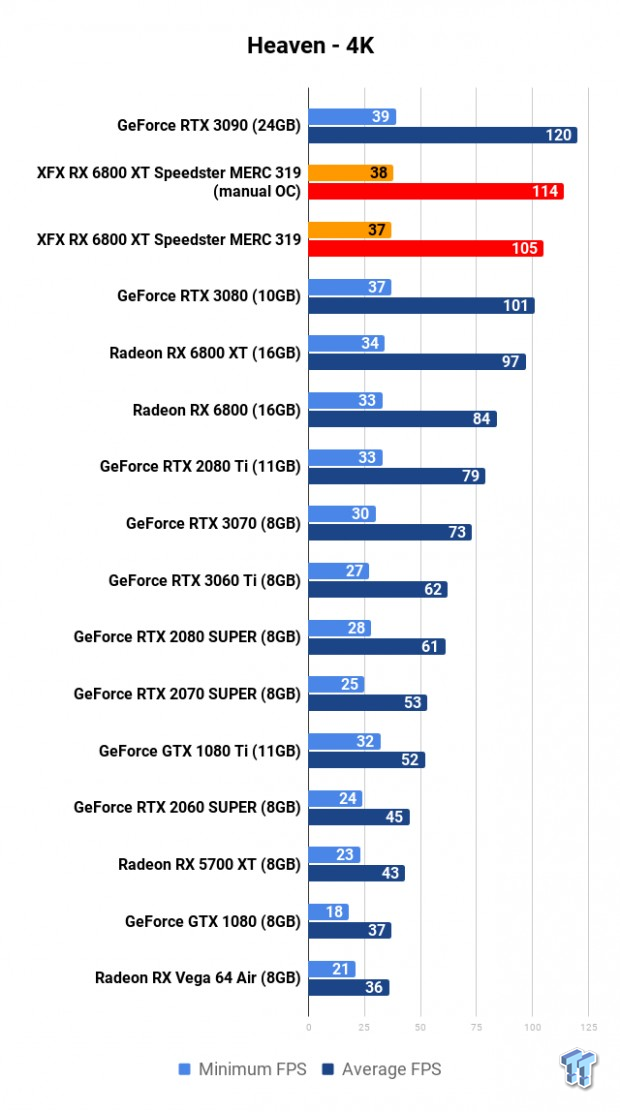
Benchmarks - 1080p
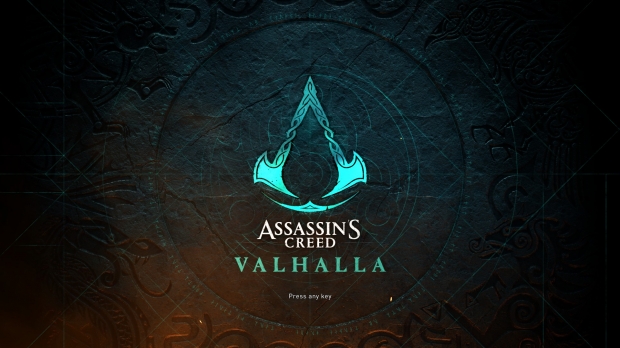


Assassin's Creed: Valhalla is the latest game to be inserted into our benchmark suite, with Ubisoft Montreal using its AnvilNext engine to power the game. It scales really well across the cards, and has some surprising performance benefits with AMD's new Big Navi GPUs.
You can buy Assassins Creed: Valhalla at Amazon.
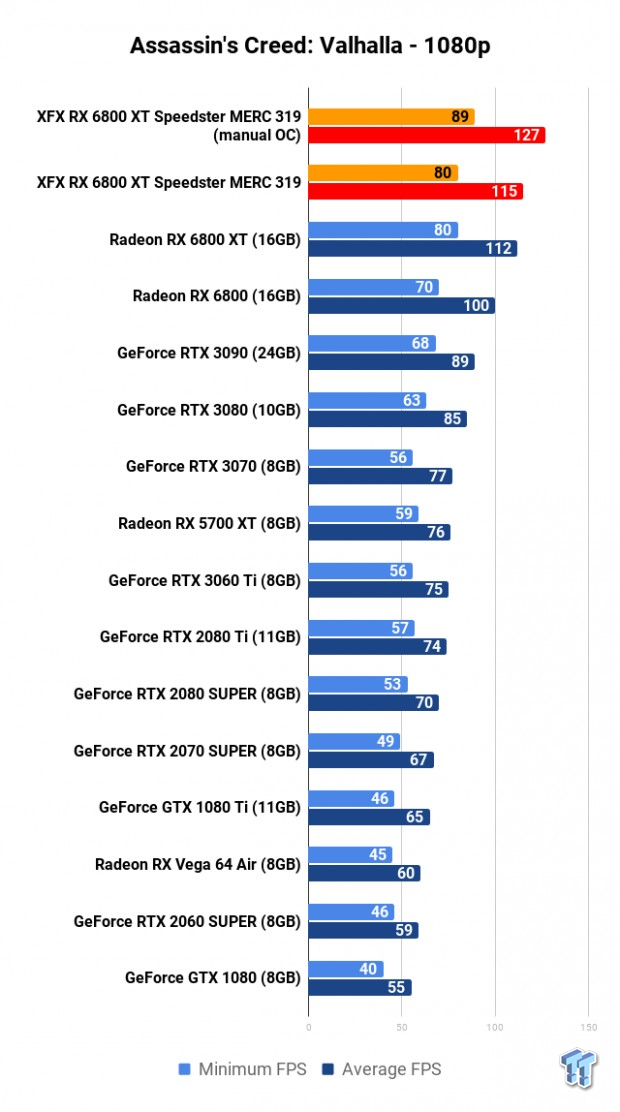

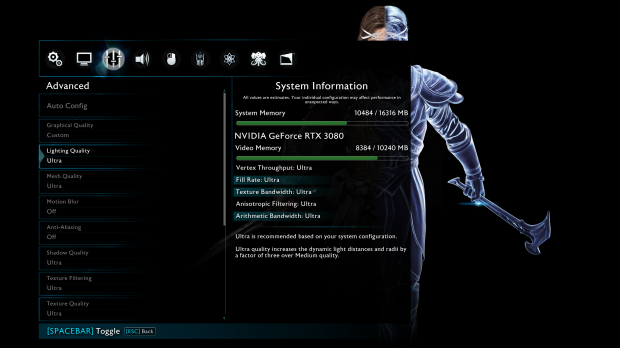

Middle-earth: Shadow of War is a sequel to the popular Shadow of Mordor, which was powered by the Lithtech engine. When cranked up to maximum detail, it will chew through your GPU and its VRAM like it's nothing.
You can buy Middle-earth: Shadow of War at Amazon.

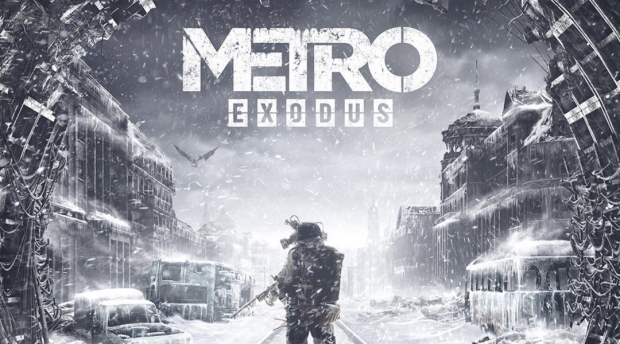
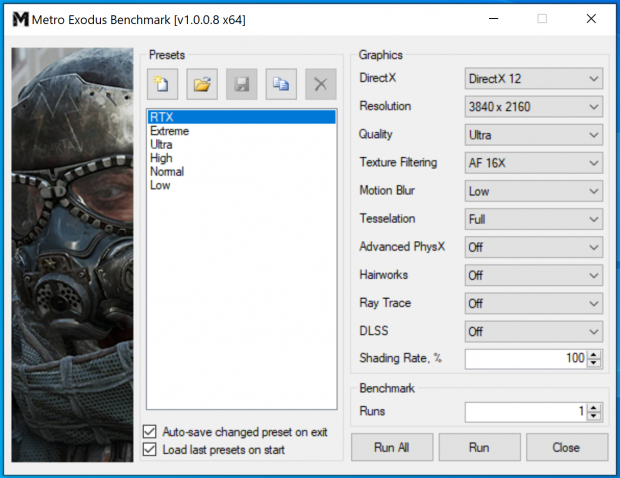
Metro Exodus is one of the hardest tests that our graphics cards have to go through, with 4A Games' latest creation being one of the best looking games on the market. It is a serious test that pushes GPUs to their limits, and also features RTX technologies like DLSS.
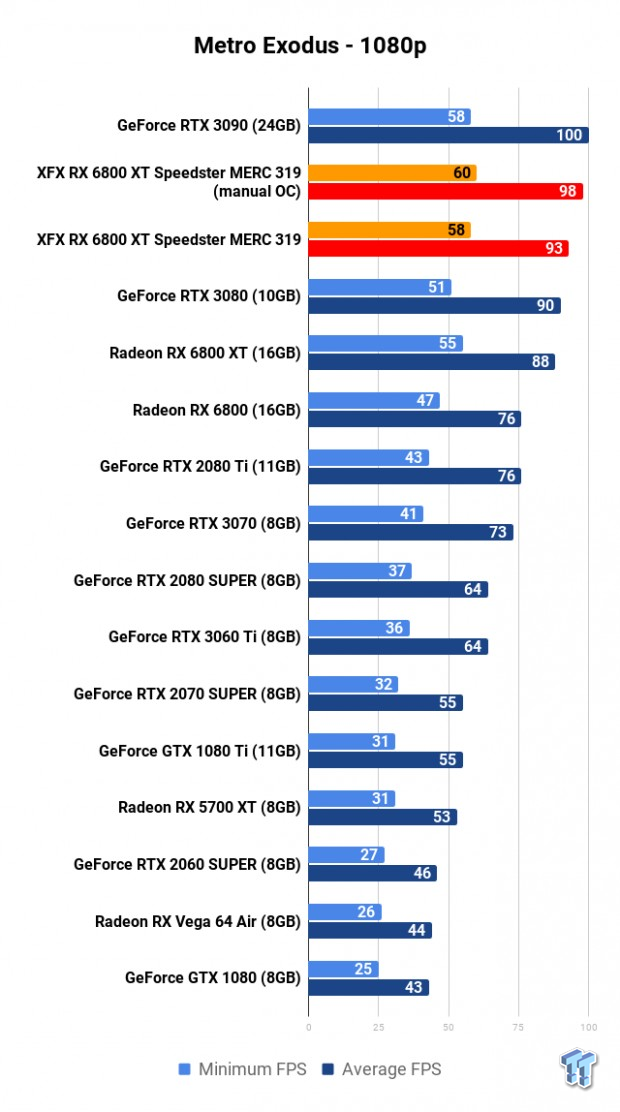

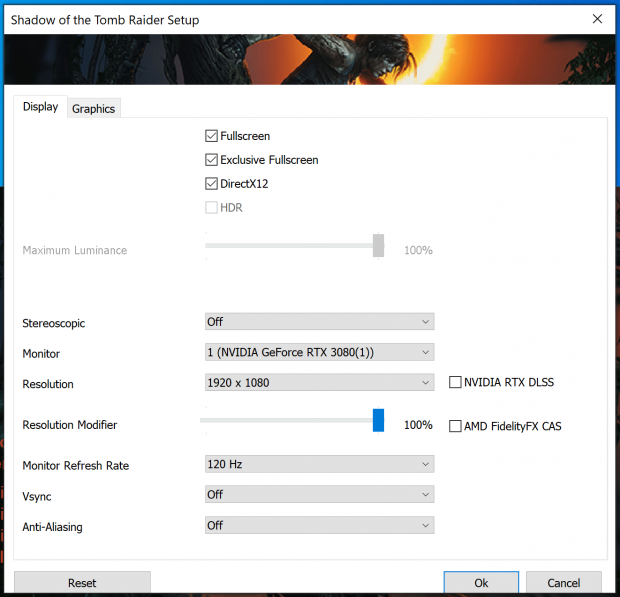

Shadow of the Tomb Raider is one of the latest games to join our graphics card benchmark lineup, with the game built using the Foundation engine as a base, the same engine in Rise of the Tomb Raider. Eidos Montreal R&D department made lots of changes to the engine during the development of Shadow of the Tomb Raider to make it one of the best-looking games out right now.

1080p Benchmark Performance Thoughts
Check out that Assassin's Creed: Valhalla performance at 1080p on the XFX Radeon RX 6800 XT Speedster MERC 319... 127FPS when overclocked, up from 115FPS stock and up from the 112FPS on the reference Radeon RX 6800 XT. We're tapping out in most games here at 1080p, so let's move onto 1440p.
Benchmarks - 1440p

Assassin's Creed: Valhalla is the latest game to be inserted into our benchmark suite, with Ubisoft Montreal using its AnvilNext engine to power the game. It scales really well across the cards, and has some surprising performance benefits with AMD's new Big Navi GPUs.
You can buy Assassins Creed: Valhalla at Amazon.
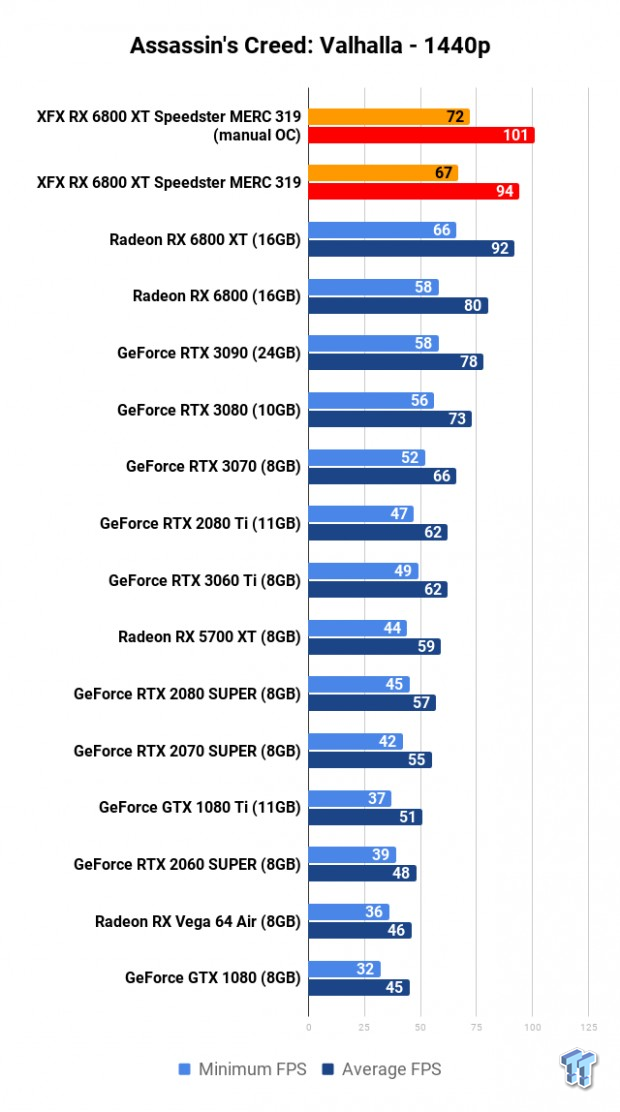

Middle-earth: Shadow of War is a sequel to the popular Shadow of Mordor, which was powered by the Lithtech engine. When cranked up to maximum detail, it will chew through your GPU and its VRAM like it's nothing.
You can buy Middle-earth: Shadow of War at Amazon.
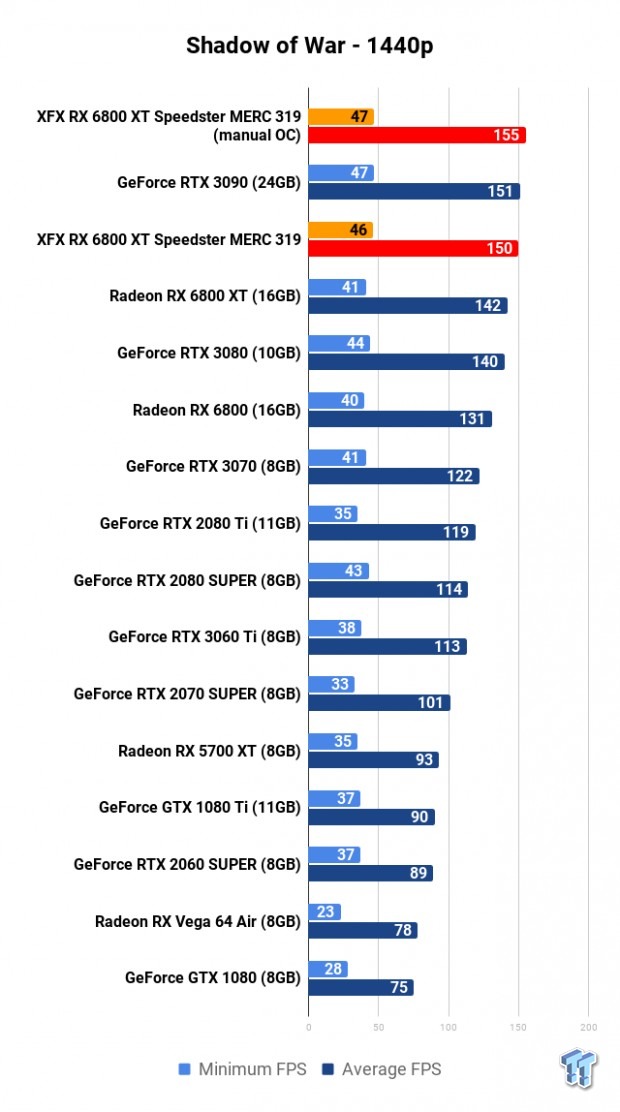

Metro Exodus is one of the hardest tests that our graphics cards have to go through, with 4A Games' latest creation being one of the best looking games on the market. It is a serious test that pushes GPUs to their limits, and also features RTX technologies like DLSS.
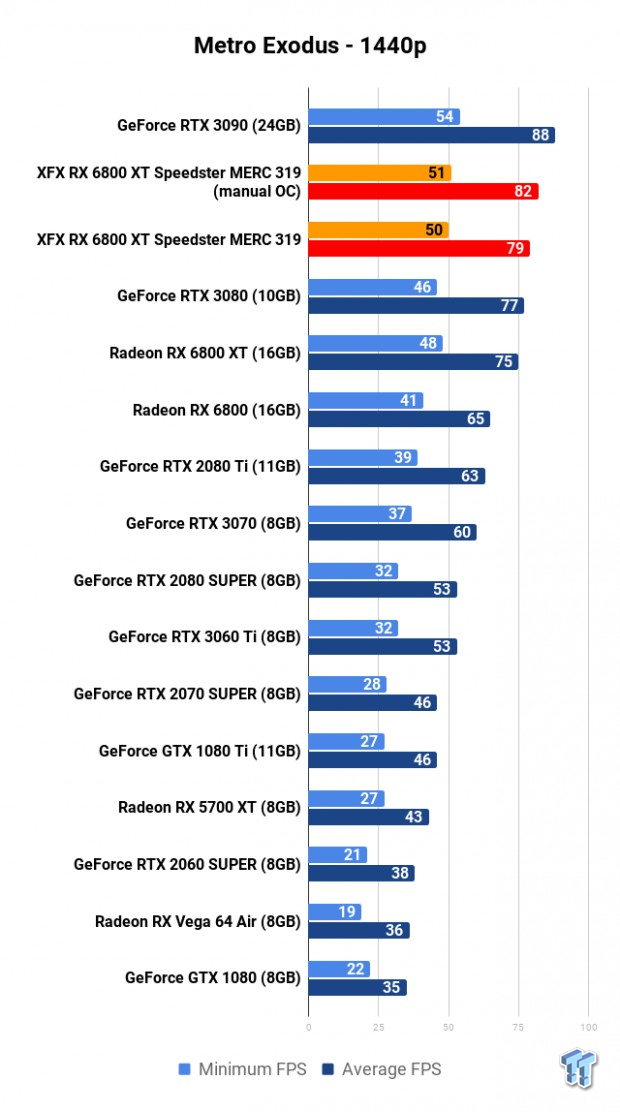

Shadow of the Tomb Raider is one of the latest games to join our graphics card benchmark lineup, with the game built using the Foundation engine as a base, the same engine in Rise of the Tomb Raider. Eidos Montreal R&D department made lots of changes to the engine during the development of Shadow of the Tomb Raider to make it one of the best-looking games out right now.
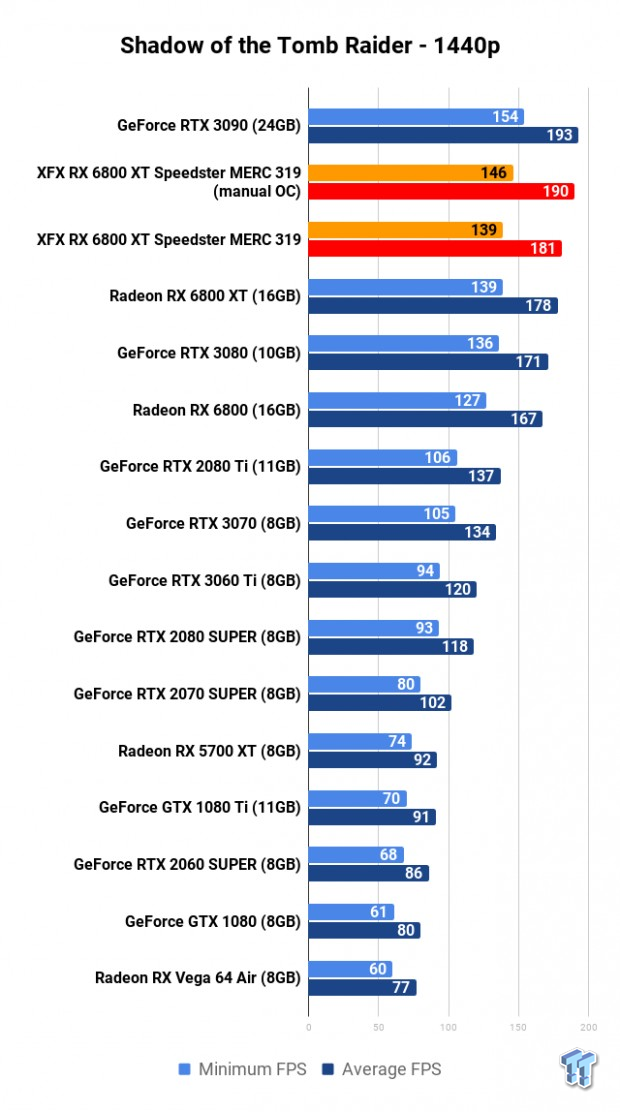
1440p Benchmark Performance Thoughts
We have the same dominance in Assassin's Creed: Valhalla at 1440p, with the great OC on the card pushing us over 100FPS at 1440p. The overclocked XFX Radeon RX 6800 XT Speedster MERC 319 overtakes the $1499 GeForce RTX 3090 in Shadow of War at 1440p -- mighty impressive.
Metro Exodus sees the overclocked card squeeze another 3FPS out of the overclock, at 82FPS versus 79FPS -- or 75FPS for the reference card. Shadow of the Tomb Raider performance at 1440p is very impressive, with 190FPS average -- 181FPS at stock, just 3FPS away from the RTX 3090.
If you're gaming @ 1440p then the RX 6800 XT is perfect if you want to go Team Red.
Benchmarks - 4K

Assassin's Creed: Valhalla is the latest game to be inserted into our benchmark suite, with Ubisoft Montreal using its AnvilNext engine to power the game. It scales really well across the cards, and has some surprising performance benefits with AMD's new Big Navi GPUs.
You can buy Assassins Creed: Valhalla at Amazon.
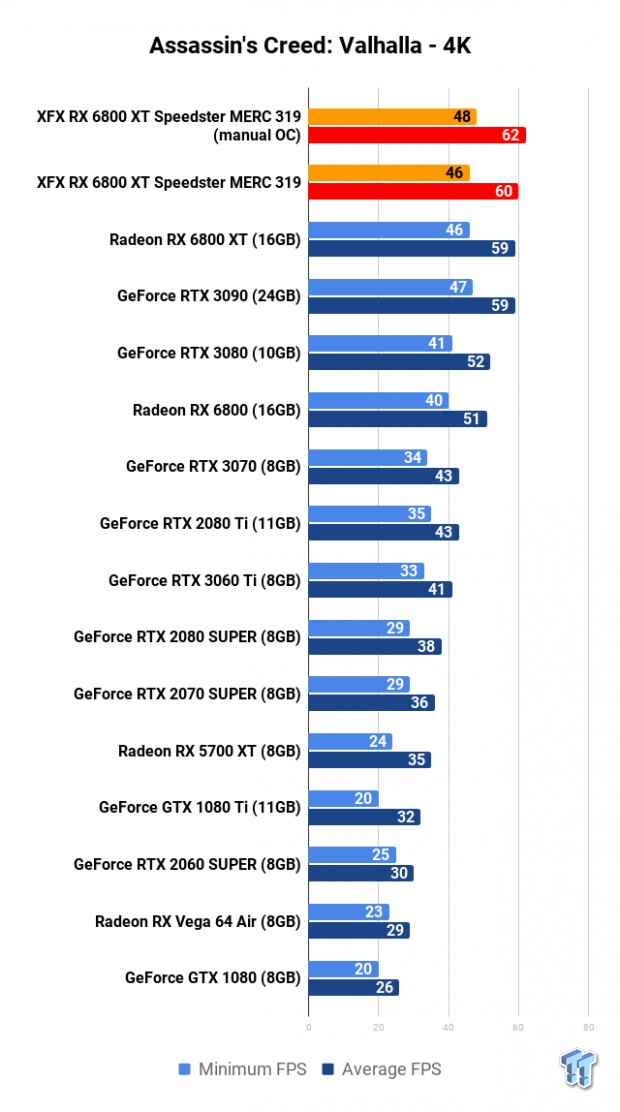

Middle-earth: Shadow of War is a sequel to the popular Shadow of Mordor, which was powered by the Lithtech engine. When cranked up to maximum detail, it will chew through your GPU and its VRAM like it's nothing.
You can buy Middle-earth: Shadow of War at Amazon.
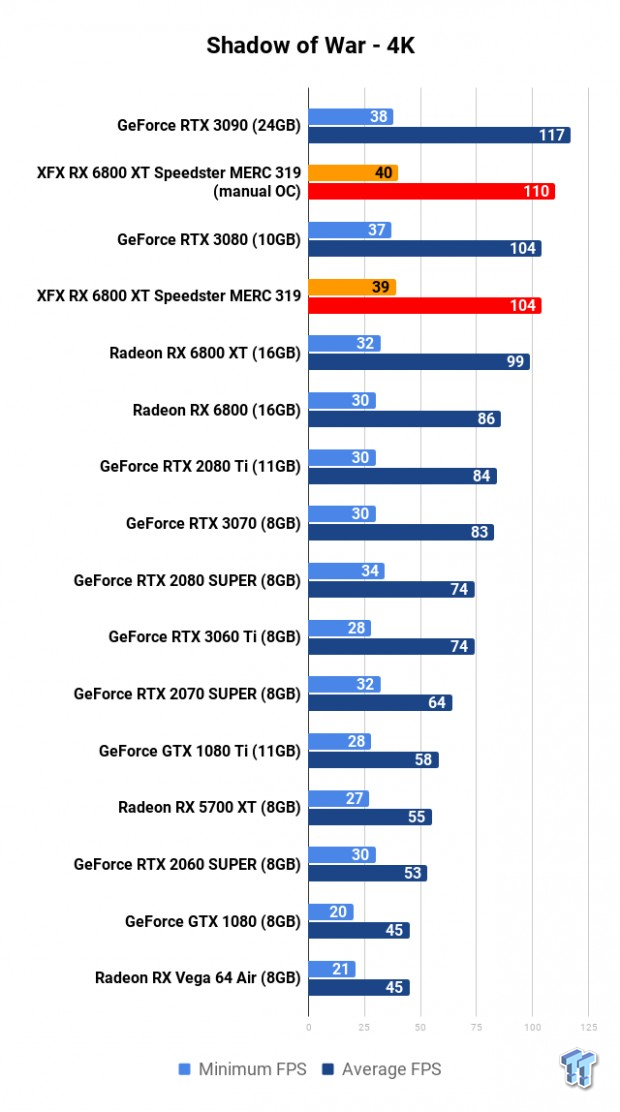

Metro Exodus is one of the hardest tests that our graphics cards have to go through, with 4A Games' latest creation being one of the best looking games on the market. It is a serious test that pushes GPUs to their limits, and also features RTX technologies like DLSS.
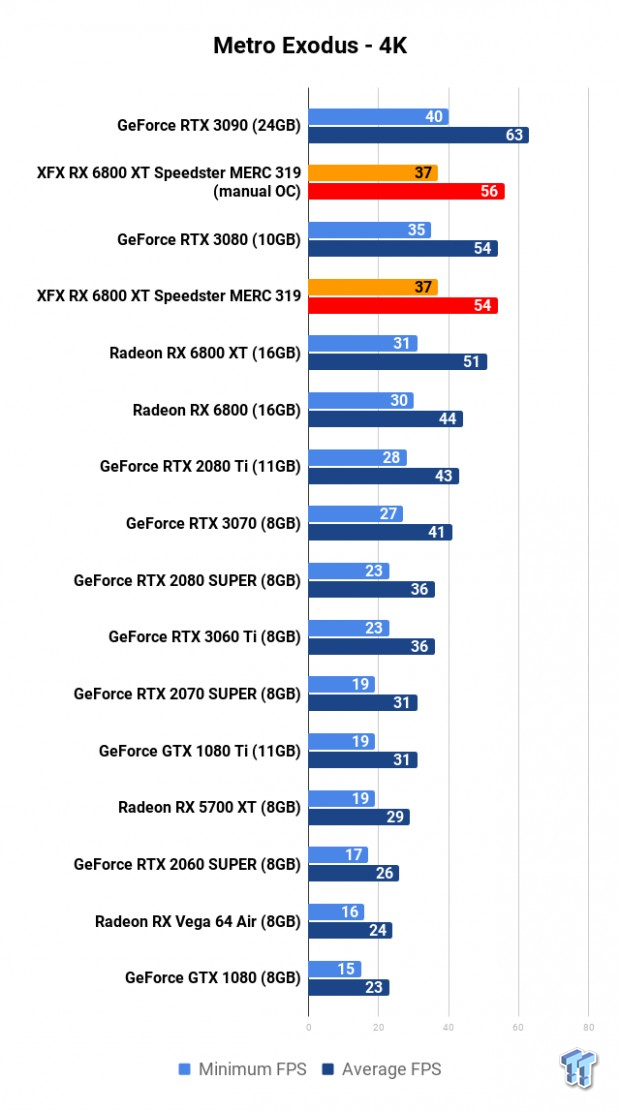

Shadow of the Tomb Raider is one of the latest games to join our graphics card benchmark lineup, with the game built using the Foundation engine as a base, the same engine in Rise of the Tomb Raider. Eidos Montreal R&D department made lots of changes to the engine during the development of Shadow of the Tomb Raider to make it one of the best-looking games out right now.
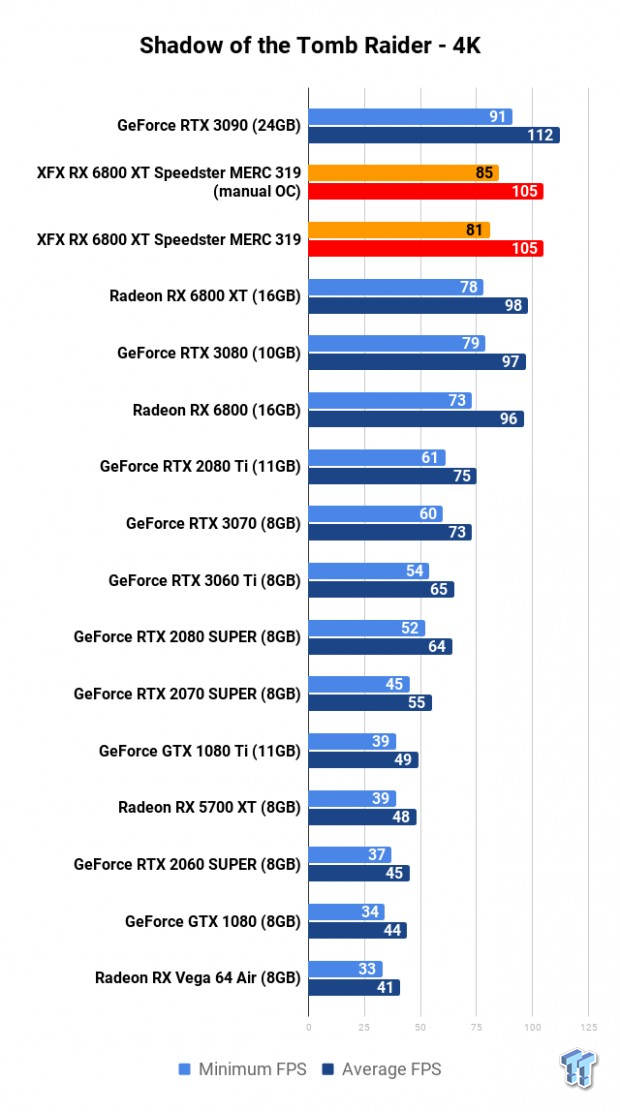
4K Benchmark Performance Thoughts
Assassin's Creed: Valhalla is an AMD friendly game, but that overclocked XFX RX 6800 XT Speedster MERC 319 is really flexing its muscle here at 4K -- 62FPS average. Impressive stuff!! The RTX 3090 is doing 59FPS here for comparison, RTX 3080 with 52FPS.
Shadow of War sees another 6FPS squeezed out of the card, hitting 110FPS at 4K -- while Metro Exodus gets closer to that golden 60FPS line with 56FPS average when overclocked. Shadow of the Tomb Raider is great here once again, bypassing 100FPS at 4K.
Overclocking
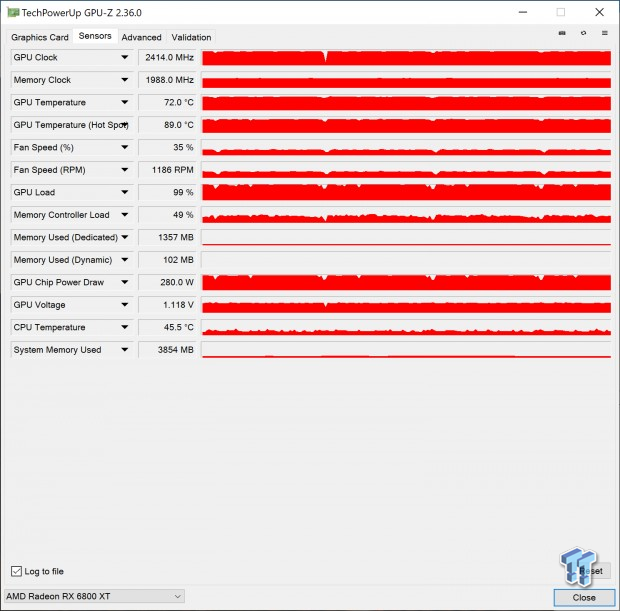
Out of the box I was seeing just over 2400MHz out of the XFX Radeon RX 6800 XT Speedster MERC 319, with the GPU sitting at around 72C while the GPU hot spot is at 89C -- the fans are whisper quiet here, however. XFX's excellent cooling on the card has the fans at just 35% and just 1200RPM -- nice and quiet, while the GPU is at just 72C.
You can adjust this easily and achieve a nice balance of virtual silence, to 70C or so -- an excellent achievement. But now let's move onto overclocking.

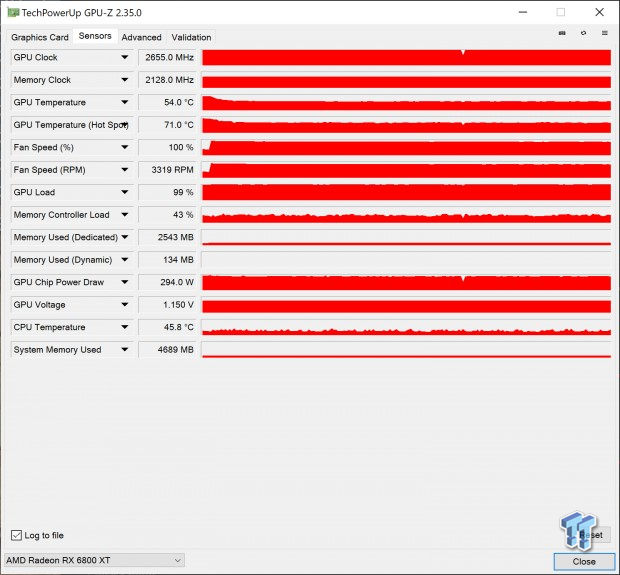
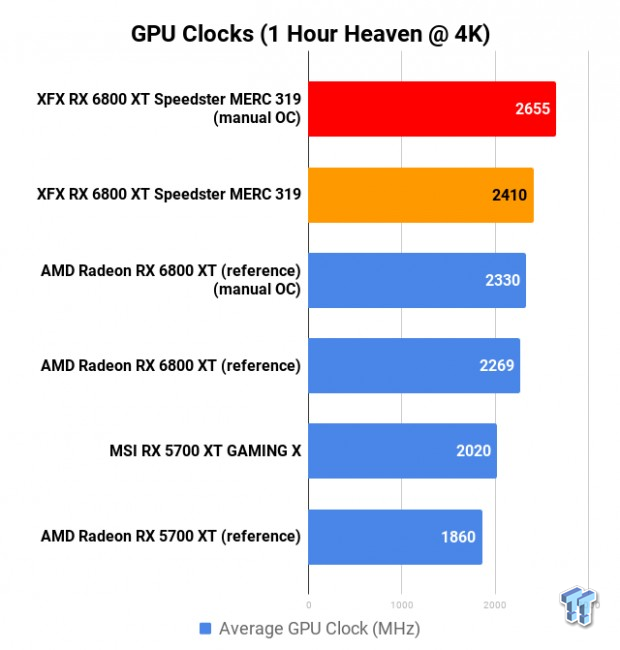
I was able to squeeze a great OC out of the XFX Radeon RX 6800 XT Speedster MERC 319, with GPU boosted up to 2655MHz -- and it would peak a little higher than that, too. I could get it up to 2700MHz but it would crash, so 1% lower on the GPU clock and it was stable without an issue.
Better yet, with the fans at 100% the GPU temperature was just 54C when the card was fully loaded -- that is very, very impressive XFX. I think we have one of the highest-clocking custom Radeon RX 6800 XT cards here so far, but I will make sure of that after I've reviewed a few of them -- that's a few days away.
Power Consumption & Temps
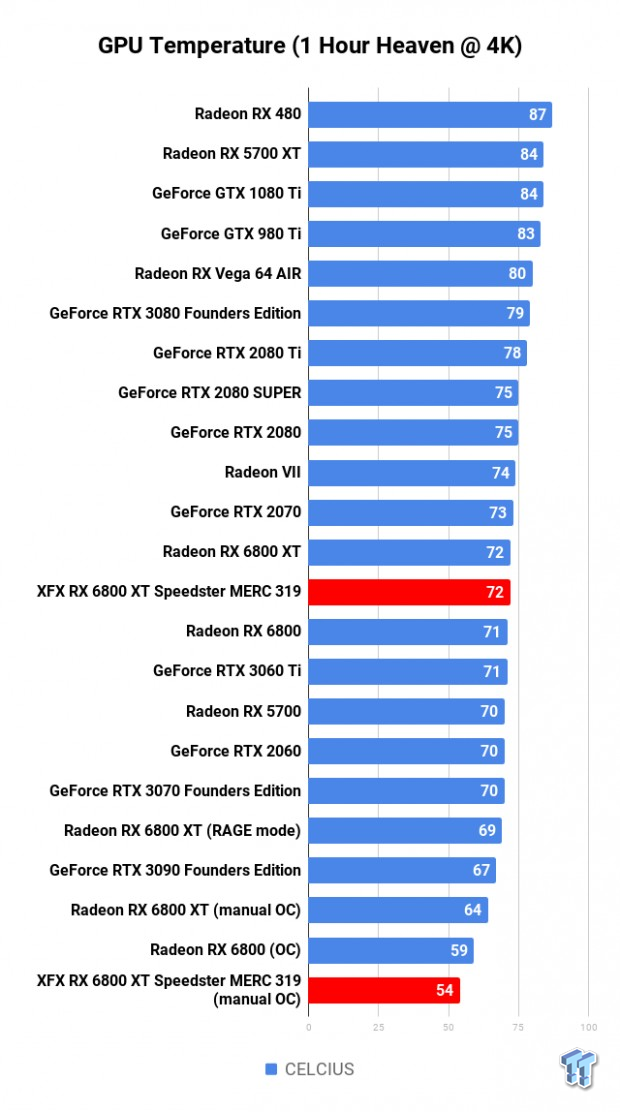
XFX has a cool card that operates at 72C -- the same as the reference card, but just much quieter -- and with much more OC potential and that same near-silent operation when gaming away.
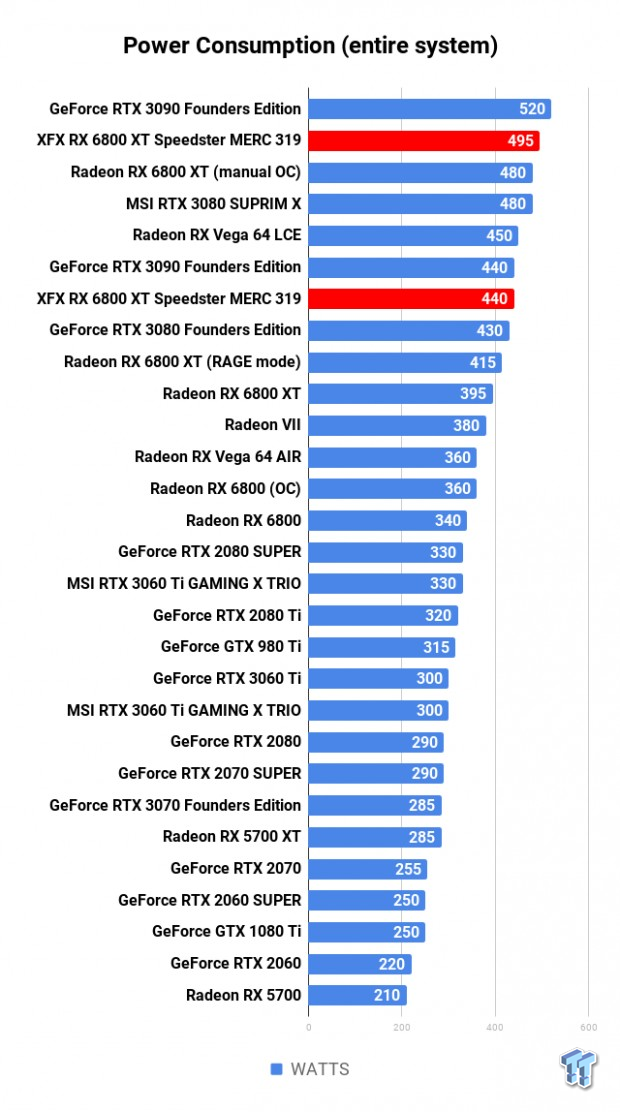
Power consumption numbers aren't much different to AMD's own Radeon RX 6800 XT reference graphics card when overclocked, but the normal power consumption is up about 50W over the reference card.
What's Hot, What's Not
What's Hot
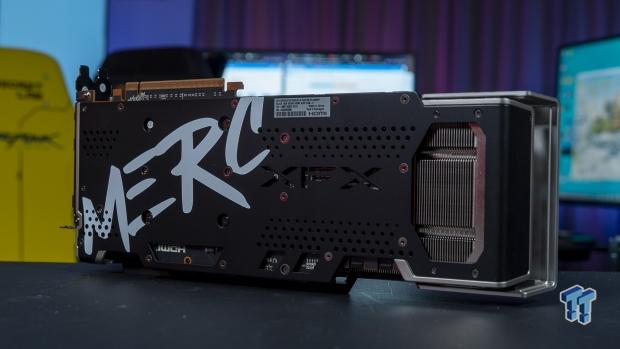
- OVERSPECED design -- uses the RX 6900 XT power circuitry: XFX has some great work across the entire board here with the Radeon RX 6800 XT Speedster MERC 319, with the company going with an overspeced design -- using the same power circuitry from the Radeon RX 6900 XT for its new RX 6800 XT Speedster MERC 319 for the best in power delivery.

- Powerhouse Big Navi performance: AMD already has kick ass performance out of the reference Radeon RX 6800 XT -- but XFX really revs it up a notch with the RX 6800 XT Speedster MERC 319. XFX offers stellar out-of-the-box performance at all resolutions, and some OC headroom that offers even more -- and it's all silent.
- Interesting name: Some people hate it, but it'll stand out -- that's for sure.
- Runs super, super quiet: The card sits at around 72C under load with the fans at a whisper quiet 1200RPM or so. XFX did some great work on the design of the card, right down to a great thermal design that keeps it not just cool when the fans are cranked -- but quiet when gaming.

- Overclock potential: There is some major additional performance here when you have the card overclocked -- I think I'll need to do some work on a Radeon RX 6800 XT round up and compare the XFX card against others but for now it is the best I've tested.
- Only dual 8-pin PCIe power connectors: XFX only requires dual 8-pin PCIe power connectors on their Radeon RX 6800 XT Speedster MERC 319 -- other custom Radeon RX 6800 XTs require triple 8-pin PCIe power connectors which I think is ridiculolus unless it's necessary for some amazing OC. But XFX kills it there too with stellar OC headroom on the RX 6800 XT Speedster MERC 319.
What's Not
You might not like the design, but everything else is great here -- maybe we can sit here and whinge about ray tracing but I don't think that's something we need to really pull apart on these custom cards in every review. We'll take a deeper look into ray tracing, etc in 2021 as the game market (and its adoption of ray tracing) improves in the new year.
Other than that, this is a kick ass -- one of the best custom Radeon cards I've ever tested... all smiles here, XFX.
Final Thoughts

XFX improves in every way possible with its new Radeon RX 6800 XT Speedster MERC 319 to the reference card from AMD, with better thermals, near-silent gaming, and some great OC abilities to boot.
The major issue is availability which is near-impossible right now, and will be into 2021 -- but once they are, and you need to make your mind up on a new Big Navi card then XFX's new Radeon RX 6800 XT Speedster MERC 319 is a champion. It offers some brutal performance at all resolutions, and its purrs along quietly.

AMD sells its own Radeon RX 6800 XT reference card for $699, while a $50 premium is attached to the XFX Radeon RX 6800 XT Speedster MERC 319 -- you're getting 16GB of VRAM over the 10GB offered by the RTX 3080 (at $649-$800+ depending on the card).
XFX has a monster with its Radeon RX 6800 XT Speedster MERC 319, which left me smiling from ear to ear.
Performance | 95% |
Quality | 90% |
Features | 90% |
Value | 90% |
Overall | 91% |
XFX's new Radeon RX 6800 XT Speedster MERC 319 is a powerful card, with near-silent gaming and some great OC headroom that saw around 2650MHz on the GPU. Impressive!

What's in Anthony's PC?
- CPU: Intel Core i5-12600K
- MOTHERBOARD: GIGABYTE Z690 AERO-G
- RAM: Corsair 32GB DDR4-3200
- GPU: NVIDIA GeForce RTX 4090 24GB
- SSD: Sabrent 4TB Rocket 4 Plus
- OS: Windows 11 Pro
- CASE: Lian Li O11 Dynamic XL
- PSU: ASUS ROG Strix 850W
- KEYBOARD: Logitech G915 Wireless
- MOUSE: Logitech G502X Wireless
- MONITOR: LG C3 48-inch OLED TV 4K 120Hz
Similar Content
Related Tags

